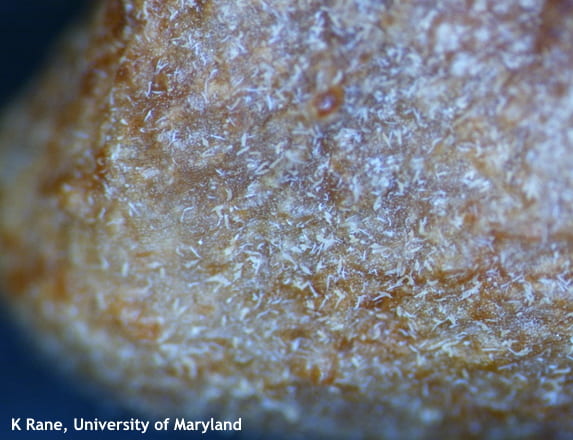Jerry Brust, IPM Vegetable Specialist, University of Maryland; jbrust@umd.edu and Karen Rane, Plant Diagnostician, University of Maryland rane@umd.edu
In December we received a sample of damaged garlic cloves from a grower on the Eastern Shore. The grower quite astutely thought it might be due to mites and he was correct. But it was not the garlic bulb mite (Rhizoglyphus spp), instead it was a mite that has not been recorded in Maryland until now, the dry bulb mite Aceria tulipae. It is the most important eriophyid mite attacking bulbous plants such as garlic, onion and tulip. This pest is a microscopic (only 1/100 inch), white mite with a cylindrical shape that tapers away from the head-end where its four legs are located. The mites go through two larval phases during their development. A complete life cycle at 75-80o F takes just 8-10 days. All life stages of the mite can overwinter on infected garlic while in storage and all stages also can survive in the soil on wild and cultivated Allium species, including onion, garlic and leeks.
Mites can be found on the foliage of Alliums where they are mainly located in the central veins or midribs of the leaves. Once the plant leaves die, the mites move to the bulbs in the ground. The mite is then found between the layers of the bulb when in storage and will feed using their very short pincer-like mouthparts to prick the plant tissue often making brown very small pits in cloves (Fig. 1). Dry bulb mites will feed on healthy green plant tissues while bulb mites Rhizoglyphus spp, feed primarily on decaying tissue, thus making the dry bulb mites much more of a problem for garlic and onion growers. Light infestations of this mite are very difficult to detect and is the reason infested bulbs can be used as seed in a field.
Figures 2, 3 and 4 do an excellent job of showing how hard it is to actually detect even a very large population of dry bulb mites on a garlic clove. Figure 2 shows the clove under low magnification with large areas of feeding damage (browning tissue) with a whitish ‘dust’ to the left in the picture (you cannot see any mites yet), magnifying this further you can see in Figure 3 the white ’dust’ now can be seen as tiny white thread-like shapes and Figure 4 under greater magnification shows hundreds of these cylindrical or thread-like shapes—all being dry bulb mites. Most of the mites on this bulb were dead most probably due to the drying process of the bulb.
Most, but not all management tactics involve cultural controls. The first is to rotate out of a field that is known to have the mite for at least 3-4 years making sure there are no volunteer or wild Allium species left in the field during the rotation. Be sure to plant clean seed, as infested cloves are the most frequent source of infection in the field. Flood irrigation or even heavy winter rains can reduce these mite populations. Soaking seed stock for 24 hours immediately before planting in a 2% soap (do not use a detergent) and 2% mineral oil water bath will greatly reduce mite populations in the field. Light or moderate infestations are usually controlled via the normal drying process prior to storage. Dusting bulbs with sulfur prior to planting has reduced populations in the field. Be sure to control any wild Allium species in the field before and after planting. In storage the mites’ feeding can cause the cloves to desiccate and shrivel. Dry bulb mite feeding may also open the bulb up to soft rot bacteria resulting in rotting bulbs. Although hot water treatment of the seed garlic at 130º F for 10–20 minutes can give you good control of the mites it will more than likely damage the bulbs and reduce germination. So be careful with this last recommendation and use only as a last option.
Figure 1. Feeding damage on garlic clove by dry bulb mites
Figure 2. Garlic clove with brown areas (left side) showing dry bulb mite feeding damage with a white ‘dust’
Figure 3. Area of garlic clove with heavy mite feeding under greater magnification showing tiny white thread-like objects
Figure 4. Greater magnification of Fig. 2 showing 100s of dry bulb mite bodies




